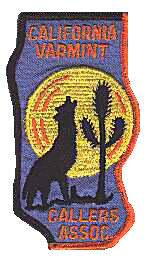|
The California
Varmint Callers Association
The first varmint hunting site on the net! The California Varmint Callers maintains this webpage for the benefit of all varmint and predator hunters.
|
||
|
|
Unfortunately, the habitat for many animal species is in decline. Animals
such as the North American wolf have been eliminated from their former range.
Some animals such as the coyote have expanded their range by constantly adapting
to a changing environment. It is now found in 49 states. Coyotes were not
previously found east of the Mississippi River and it has been only recently
in this century that they have made a home in Alaska. The nature of the animal
together with its physical make up are assets that appear to be unbeatable
no matter what measures have been used to eradicate them.
Today, there are certainly more coyotes in North America by a factor of ten
to one than there were when Columbus discovered America. This tremendous
increase has been due to many factors such as the disappearance of the coyote's
fatal enemy, the timber wolf. Man is also the convenient provider of his
food by the raising of sheep and other livestock and by man's own immense
waste of food resources. Very simply, coyotes are glad to eat whatever humans
throw away. Coyotes eat about everything including insects, dates, cantaloupe,
avocados, or if hungry enough, what ever is available.
Often one may be easily mislead about the apparent weight of a coyote. A
mature coyote of either sex seen when the fur is prime, outwardly appears
to be comparable in weight to the smallest of the gray wolf forms. The Mexican
Wolf, which occurs in Arizona and New Mexico generally weighs between 60
and 90 pounds. The coyote usually ranges in weight from 18 to 34 lbs. From
New Mexico, male coyotes averaged 24.4 pounds and females averaged 22.2 pounds.
Coyotes from south western Oklahoma averaged 25 pounds. Texas coyotes averaged
23 lbs. for females and 27 lbs for males. Exceptionally heavy animals do
occur. A male coyote killed in South Dakota in 1944 weighed 42 pounds. A
male coyote taken in Jackson, Michigan weighed 53 1/2 pounds. The heaviest
coyote on record by the U.S. Fish and Wildlife service weighed 74 3/4 pounds,
and was killed near Afton, Wyoming.
People have told me that coyotes are much bigger in the Rocky Mountains of
Montana and Canada. Rocky Mountain coyotes are about the same size ranging
from 20 to 32 pounds for an average of 27.4 pounds. I have been hunting for
over 20 years and early on began to notice individual differences in coloration,
weight, size, and body form. I began photographing and weighing each animal
so I could determine whether individual differences were due to their location
or other dependent variables. My hunts have taken me to about a hundred mile
radius from my home in widely ranging terrain and habitat.
The colors of the local coyotes vary from a mottled yellow to brown, to a
pure gray, and even an occasional solid dark gray. Some have a lot of red
hair on their legs and faces, some are yellow to brown with black along the
ridge of the back. Some coyotes are short and stubby and others are long
and lanky. Some have long, sharp, pointed noses while others have shorter,
wider muzzles. Their differences are not dependent upon locality. Perhaps
that is because coyotes are not very territorial and wander great distances.
Tagged coyotes have been found a hundred miles away from their release point.
Occasionally, albino coyotes are found and statistically, this occurs about
once in every 250,000 births. Albino coyotes have been found in most of the
western states. There seems to be little or no relationship between where
coyotes live and their coloration, size, and body type. Sources: The Clever Coyote by Stanley P. Young and Hartley H.T. Jackson Coyotes: Predators and Survivors, Charles L. Cadieux
The California Varmint Callers is a nonprofit organization.
|
|
